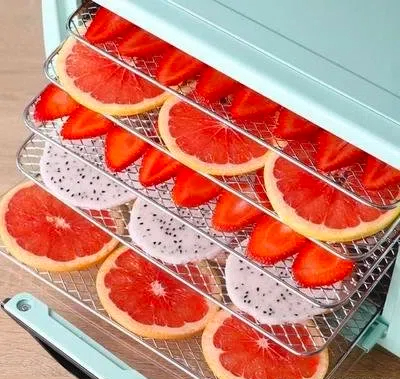
Content Menu
● Introduction
● Understanding Food Dryers
● How Food Dryers Work
● Benefits of Using Food Dryers
● Heat Pump Dryers vs. Traditional Dryers
● Comparison of Energy Efficiency
● Environmental Impact
● Cost Analysis
● Applications of Food Dryers
● Choosing the Right Food Dryer
● Maintenance and Care for Food Dryers
● Conclusion
● Frequently Asked Questions
>> 1. What is the best food dryer for home use?
>> 2. How do I clean my food dehydrator?
>> 3. Can I dry meat in a food dryer?
>> 4. What are the energy costs associated with food dryers?
>> 5. How long does it take to dry fruits and vegetables?
Introduction
Food drying is an ancient preservation method that has gained renewed interest in recent years due to its health benefits and cost-effectiveness. By removing moisture from food, drying inhibits the growth of bacteria, yeasts, and molds, allowing food to be stored for extended periods without refrigeration. This article explores the various types of food dryers, their benefits, and how to choose the right one for your needs.

Understanding Food Dryers
Food dryers, also known as dehydrators, are appliances designed to remove moisture from food. They come in various forms, including electric dehydrators, solar dehydrators, and heat pump dryers. Each type operates on the same principle: circulating warm air around the food to evaporate moisture.
How Food Dryers Work
Most food dryers use a fan to circulate warm air, which is heated by a heating element. The warm air passes over the food, absorbing moisture and carrying it away. This process can take several hours, depending on the type of food and the drying method used.
Benefits of Using Food Dryers
Using a food dryer offers numerous advantages:
1. Nutritional Preservation: Drying helps retain the nutritional value of food, making it a healthier option compared to other preservation methods.
2. Cost-Effectiveness: By drying seasonal fruits and vegetables, you can save money and reduce food waste.
3. Convenience and Versatility: Food dryers can be used to prepare a variety of snacks, including dried fruits, jerky, and herbs.

Heat Pump Dryers vs. Traditional Dryers
Heat pump dryers are a modern alternative to traditional food dryers. They are known for their energy efficiency and lower environmental impact. Unlike conventional dryers that use high temperatures, heat pump dryers operate at lower temperatures, preserving the quality of the food while using less energy.
Comparison of Energy Efficiency
Heat pump dryers can be up to 50% more energy-efficient than traditional electric dryers. This efficiency not only reduces energy costs but also minimizes the carbon footprint associated with food drying.
Environmental Impact
Traditional dryers often rely on fossil fuels or high electricity consumption, contributing to greenhouse gas emissions. In contrast, heat pump dryers use eco-friendly refrigerants and are designed to operate with minimal energy waste.
Cost Analysis
While heat pump dryers may have a higher initial purchase price, their long-term savings on energy bills can make them a more economical choice over time.
Applications of Food Dryers
Food dryers are versatile appliances suitable for both home and commercial use. They can be used to dry a wide range of foods, including:
1. Fruits: Apples, bananas, and berries can be dried to create healthy snacks.
2. Vegetables: Carrots, tomatoes, and peppers can be dehydrated for soups and stews.
3. Meats: Jerky can be made at home using a food dryer, providing a high-protein snack option.
Choosing the Right Food Dryer
When selecting a food dryer, consider the following factors:
1. Capacity: Choose a model that fits your drying needs, whether for personal use or larger batches.
2. Features: Look for adjustable temperature settings, timers, and ease of cleaning.
3. Price: Compare different brands and models to find one that fits your budget.
Maintenance and Care for Food Dryers
Proper maintenance is essential for the longevity of your food dryer. Here are some tips:
1. Cleaning: Regularly clean the trays and interior to prevent the buildup of food particles and odors.
2. Troubleshooting: Familiarize yourself with common issues, such as uneven drying or overheating, and how to resolve them.
Conclusion
Food drying is a practical and efficient way to preserve food while retaining its nutritional value. With various types of food dryers available, including energy-efficient heat pump dryers, consumers can choose the best option for their needs. As technology advances, we can expect even more innovative solutions in the food drying industry.

Frequently Asked Questions
1. What is the best food dryer for home use?
The best food dryer for home use depends on your specific needs, but popular models include the Excalibur and Nesco dehydrators, known for their reliability and performance.
2. How do I clean my food dehydrator?
To clean your food dehydrator, disassemble the trays and wash them with warm soapy water. Wipe down the interior with a damp cloth and ensure all parts are dry before reassembling.
3. Can I dry meat in a food dryer?
Yes, you can dry meat in a food dryer. Ensure the meat is sliced thinly and marinated if desired, then follow the manufacturer's instructions for drying times and temperatures.
4. What are the energy costs associated with food dryers?
Energy costs vary based on the model and usage, but heat pump dryers are generally more energy-efficient, leading to lower operational costs compared to traditional models.
5. How long does it take to dry fruits and vegetables?
Drying times vary by food type and thickness, but most fruits and vegetables take between 4 to 12 hours to dry completely in a food dehydrator.












